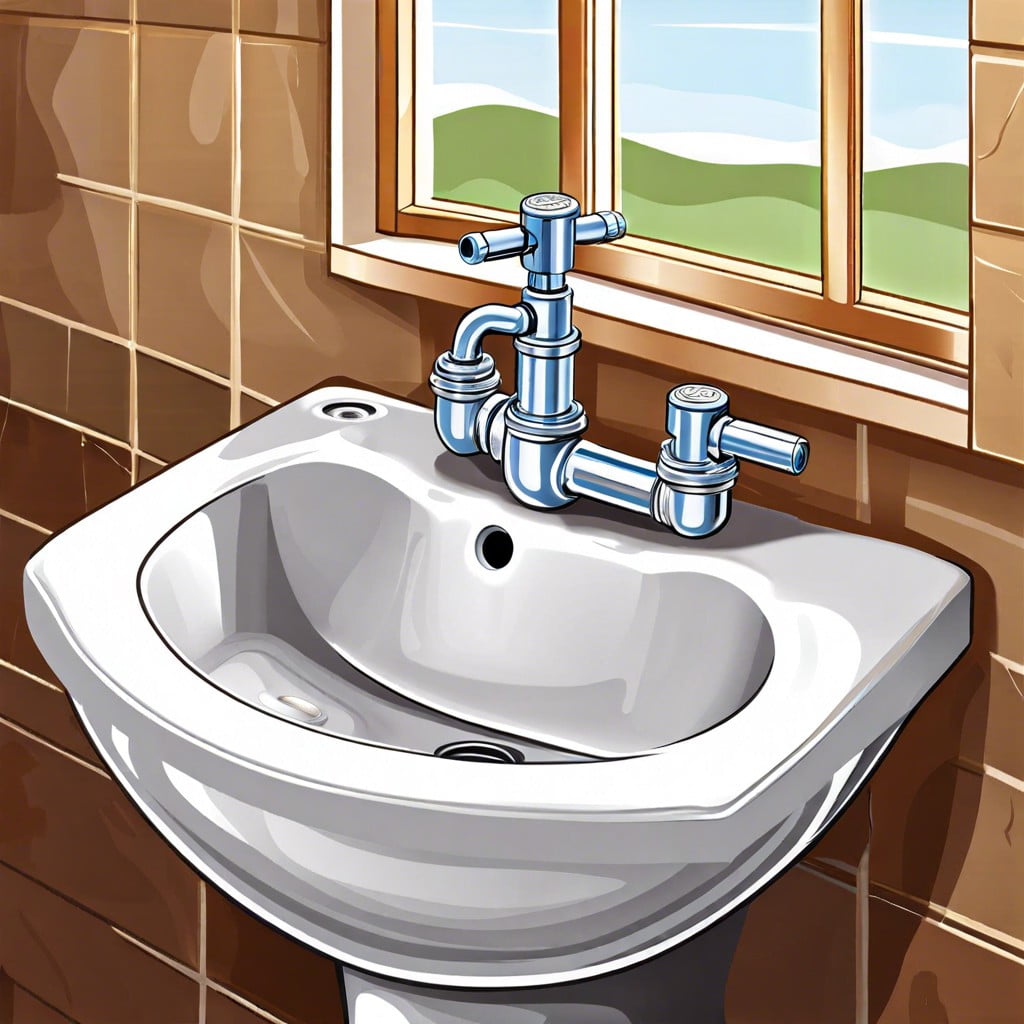Last updated on
This article will guide you through the steps to shut off water under the sink in your bathroom.
Key takeaways:
- Locate the main shut-off valve for your home’s water supply.
- Identify the local shut-off valves under your bathroom sink.
- Safely turn off the water by gently turning the valves clockwise.
- Check for leaks under the sink once the water is off.
- Seek professional help if the valves are stuck, there are signs of leakage, or you have outdated fixtures.
Locating the Main Shut-off Valve

Most homes have their main water shut-off valve located near the perimeter, typically where the main water line enters the house. It can often be found in basements, garages, or utility areas. This valve completely stops the water flow to all plumbing fixtures in your home, not just the bathroom.
For those living in warmer climates, it’s worth checking outside. The valve might be nestled near the foundation, often protected by a utility box in the ground or on an exterior wall.
Recognizing this valve is important. It usually has a wheel-like handle or a lever. Turning the lever clockwise or the handle to the right will shut off the water supply. This universal ‘righty-tighty’ rule simplifies remembering how to stop the flow in emergencies or for repairs.
Identifying the Local Shut-off Valves
Under your sink, you’ll usually find two knobs: one for hot water and one for cold. These are your local shut-off valves. They’re typically made of silver or white plastic, chrome, or sometimes brass.
To determine which is which, feel the pipes. The one that gets hot when you run hot water in your sink is connected to your hot water valve. The other is for cold water.
Turning these knobs clockwise will stop the flow of water to the sink without affecting water supply to other areas of your home. This is particularly handy for repairs or emergencies when you don’t want to disrupt the entire house.
Steps to Safely Turn Off the Water
First, ensure your hands are dry before touching any plumbing fixtures to avoid any accidental slips or electrical hazards. Then, locate the valve knobs, which typically resemble small round or oval handles under the sink.
Turn each knob clockwise until it stops; this movement typically follows the old adage, “righty-tighty,” implying that turning to the right will cease the flow of water. It’s crucial to perform this action gently to prevent damaging the valves, which could lead to leaks.
After shutting off the valves, open the sink faucets to release any water left in the pipes. This step helps lower the pressure in the plumbing lines and minimizes the risk of a water burst when you resume your repair or maintenance work.
If the valves haven’t been used in a while, they might be stiff. Applying too much force can break them. If they won’t budge, a spray of WD-40 can help loosen them, but turning them should still be done with care.
Following these simple steps will effectively stop the water flow, allowing you to proceed with your under-sink tasks without the worry of water complications.
Checking for Leaks Once Water Is Off
Once the water is turned off, grab a flashlight and inspect the area under the sink. Look for any droplets of water or damp spots on the pipes. Silence is golden here; listen closely for the sound of dripping water, which can indicate a small leak. Feel around the pipe joints with your fingertips; even a slight wetness can signal a problem.
If you discover any signs of leaking, tighten the fittings slightly with a wrench. Be gentle—over tightening can lead to more damage. If that doesn’t fix the issue, putting a bucket underneath as a temporary solution can catch drips and prevent damage to your cabinet while you plan your next steps, potentially consulting a professional.
Keeping an eye on these signs of leakage after shutting off the water can prevent major plumbing disasters and maintain the integrity of your bathroom’s plumbing system.
When to Seek Professional Help
Sometimes, despite your best efforts, turning off the water under the sink might hit a snag that calls for a pro’s touch. Here are a few scenarios where dialing up a plumber is the smart move:
– Stuck valves: If the valve won’t budge and you’ve given it a fair amount of elbow grease, a plumber can handle it without causing damage.
– Signs of leakage: Seeing water after you’ve turned the valve could indicate a bigger issue. A professional can pinpoint the cause and fix it promptly.
– Outdated fixtures: Older valves and pipes might need an expert upgrade to prevent future problems and ensure they operate smoothly.
If you’re unsure at any step, remember that calling a plumber can save you time and prevent costly mistakes. They have the tools and know-how to quickly resolve issues while keeping your bathroom in top shape.
Recap




